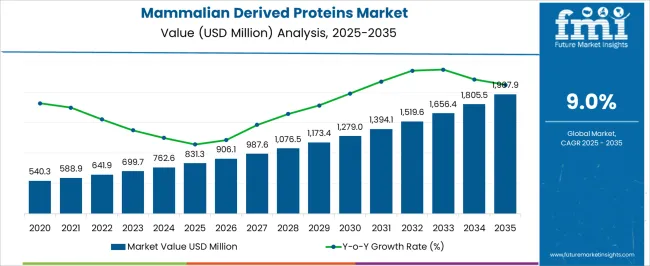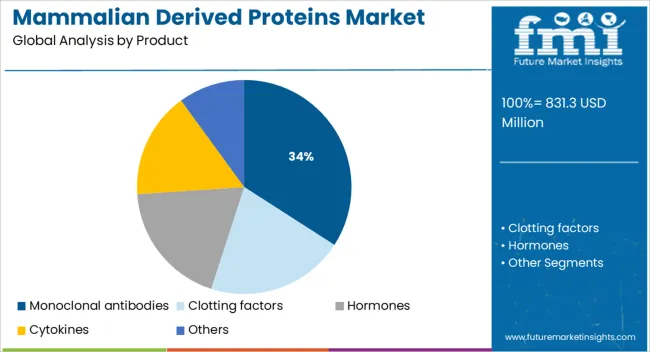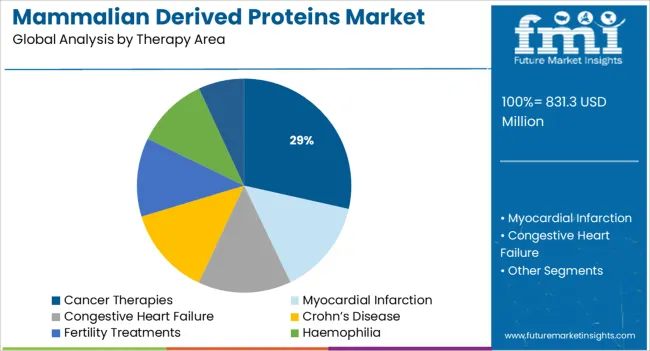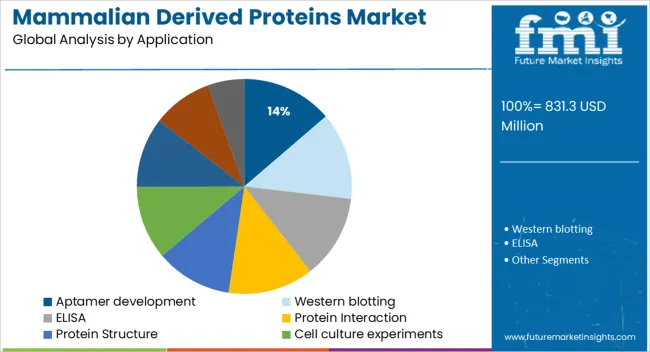The Mammalian Derived Proteins Market is estimated to be valued at USD 831.3 million in 2025 and is projected to reach USD 1967.9 million by 2035, registering a compound annual growth rate (CAGR) of 9.0% over the forecast period.

| Metric | Value |
|---|---|
| Mammalian Derived Proteins Market Estimated Value in (2025 E) | USD 831.3 million |
| Mammalian Derived Proteins Market Forecast Value in (2035 F) | USD 1967.9 million |
| Forecast CAGR (2025 to 2035) | 9.0% |
The mammalian derived proteins market is witnessing accelerated growth due to advancements in biopharmaceutical research, increasing reliance on cell-based expression systems, and the expanding pipeline of protein therapeutics. Mammalian cell cultures, particularly CHO and HEK cells, continue to be favored for their capability to produce complex proteins with human-compatible post-translational modifications.
Heightened regulatory approvals of monoclonal antibody-based therapies and rising investments in biosimilar development are driving expansion across global markets. Pharmaceutical manufacturers are also optimizing upstream and downstream processes to scale up production efficiency and ensure consistency in protein expression and purification.
The role of mammalian-derived proteins in targeted therapy, diagnostic assay development, and vaccine production is expected to grow significantly with the increasing focus on personalized medicine and advanced immunotherapies. Future growth will also be supported by collaborative research models between biotech firms and academic institutions focused on therapeutic innovations and clinical-grade protein development.
The market is segmented by Product, Therapy Area, Application, and End User and region. By Product, the market is divided into Monoclonal antibodies, Clotting factors, Hormones, Cytokines, and Others. In terms of Therapy Area, the market is classified into Cancer Therapies, Myocardial Infarction, Congestive Heart Failure, Crohn’s Disease, Fertility Treatments, Haemophilia, and Others. Based on Application, the market is segmented into Aptamer development, Western blotting, ELISA, Protein Interaction, Protein Structure, Cell culture experiments, Antibody profiling, Improved altered functions, and Others. By End User, the market is divided into Biotechnology companies, Research institutes, Contract Research organizations, and Hospitals. Regionally, the market is classified into North America, Latin America, Western Europe, Eastern Europe, Balkan & Baltic Countries, Russia & Belarus, Central Asia, East Asia, South Asia & Pacific, and the Middle East & Africa.

The monoclonal antibodies product category is projected to account for 34.1% of total revenue in the mammalian derived proteins market by 2025, establishing it as the leading segment. This is due to the widespread clinical adoption of monoclonal antibodies in treating a wide range of chronic diseases, particularly autoimmune disorders and cancers.
Their high specificity, affinity, and compatibility with human immune mechanisms have positioned them at the forefront of biologic drug development. Mammalian cell expression systems have been essential in monoclonal antibody production, supporting post-translational modifications that synthetic or bacterial systems cannot efficiently replicate.
Advancements in cell line engineering and bioreactor technology have further improved yields and consistency. Moreover, ongoing clinical trials and increased regulatory approvals for biosimilar monoclonal antibodies are expanding market access globally, reinforcing the segment's continued growth and therapeutic relevance.

Cancer therapies are projected to contribute 28.5% of total revenue within the therapy area category in 2025, making it the largest therapeutic domain utilizing mammalian derived proteins. This prominence is attributed to the increasing prevalence of cancer worldwide and the significant role of targeted protein-based therapies in oncology.
Mammalian expression systems are extensively used to develop complex therapeutic proteins including monoclonal antibodies, fusion proteins, and immune checkpoint inhibitors that are central to modern cancer treatment regimens. The surge in personalized cancer treatment strategies has intensified demand for high-purity therapeutic proteins tailored to individual tumor profiles.
Additionally, oncology-focused biotech investments and expedited regulatory pathways for life-saving biologics are further accelerating the adoption of mammalian-derived proteins in cancer therapy pipelines.

Aptamer development is expected to represent 13.7% of total market revenue under the application segment in 2025, establishing it as a fast-emerging area of growth. Aptamers, which serve as high-affinity molecular recognition tools, rely heavily on mammalian derived proteins during the selection, validation, and functional screening phases.
The increasing interest in aptamer-based therapeutics and diagnostics is driving the demand for recombinant proteins with high biological relevance and stability. Mammalian expression systems provide the structural and functional complexity needed to produce such proteins, ensuring binding specificity and efficacy.
Applications range from targeted drug delivery to biosensor development, contributing to the segment's steady expansion. The convergence of aptamer research with precision medicine, molecular diagnostics, and point-of-care testing is anticipated to further elevate the role of mammalian derived proteins in this domain.
The major factor driving the mammalian derived proteins market is rising prevalence of chronic diseases like cancer and cardiac disorders. This factor act as the biggest driver for the market. Additionally, the increase in the fertility problems has raised the adoption rate of hormonal therapies across the globe.
As most of the fertility hormones are developed through mammalian cell cultures, the global mammalian derived protein market is expected to propel in the near future.
Moreover, utilizing human cell lines for the production of mammalian derived proteins is popular in the industry. Technological advancements in genome engineering has developed different approaches of expression and isolation of proteins for research purpose. This will drive the mammalian derived proteins market in the projected period.
Owing to the technological development and premier research institutes in the USA and Canada, the North American region will lead the mammalian derived proteins market. Also, the growth of the mammalian derived proteins market will be triggered by the rising prevalence of chronic diseases along with the rising infertility issues among people in this region.
Following North America, Europe will lead the market to grow due to the increasing incidence of chronic illness and rising geriatric population. Additionally, strong investment in healthcare structure will boost the market for mammalian derived proteins in Europe. In East Asia, China is estimated to drive market growth with the rising prevalence of cardiovascular diseases.
Due to the less awareness among the population in the regions like Latin America, the Middle East, and Africa, the growth rate for the mammalian derived proteins market is low.
Some of the key manufacturers of mammalian derived proteins market are F. Hoffmann-La Roche Ltd, Merck KGaA, Eli Lilly and Company, Lonza., CUSABIO TECHNOLOGY LLC., Prospec-Tany Technogene Ltd., Randox Laboratories Ltd, Geno Technology Inc., Kaneka Eurogentec S.A., Batavia Biosciences., Abnova Corporation, Cayman Chemical, SOSV LLC – IndieBio, and Bioclone Inc.
| Report Attributes | Details |
|---|---|
| Growth Rate | CAGR of 9.0% 2025 to 2035 |
| Base Year for Estimation | 2024 |
| Historical Data | 2012 to 2024 |
| Forecast Period | 2025 to 2035 |
| Qualitative Units | Revenue in USD Million and CAGR from 2025 to 2035 |
| Report Coverage | Revenue Forecast, Company Ranking, Competitive Landscape, Growth Factors, Trends and Pricing Analysis |
| Segment Covered |
Product, Therapy Area, Application, End User, Region |
| Region Covered |
North America; Latin America; Europe; East Asia; South Asia; Oceania; Middle East & Africa |
| Key Countries Profiled |
USA, Canada, Brazil, Mexico, Germany, UK, France, Spain, Italy, China, Japan, South Korea, Malaysia, Singapore, Australia, New Zealand, GCC, South Africa, Israel |
| Key Players |
F. Hoffmann-La Roche Ltd; Merck KGaA; Eli Lilly and Company; Lonza.; CUSABIO TECHNOLOGY LLC.; Prospec-Tany Technogene Ltd.; Randox Laboratories Ltd; Geno Technology Inc.; Kaneka Eurogentec S.A.; Batavia Biosciences.; Abnova Corporation; Cayman Chemical; SOSV LLC - IndieBio; Bioclone Inc |
| Customization | Available Upon Request |
The global mammalian derived proteins market is estimated to be valued at USD 831.3 million in 2025.
The market size for the mammalian derived proteins market is projected to reach USD 1,967.9 million by 2035.
The mammalian derived proteins market is expected to grow at a 9.0% CAGR between 2025 and 2035.
The key product types in mammalian derived proteins market are monoclonal antibodies, clotting factors, hormones, cytokines and others.
In terms of therapy area, cancer therapies segment to command 28.5% share in the mammalian derived proteins market in 2025.






Our Research Products

The "Full Research Suite" delivers actionable market intel, deep dives on markets or technologies, so clients act faster, cut risk, and unlock growth.

The Leaderboard benchmarks and ranks top vendors, classifying them as Established Leaders, Leading Challengers, or Disruptors & Challengers.

Locates where complements amplify value and substitutes erode it, forecasting net impact by horizon

We deliver granular, decision-grade intel: market sizing, 5-year forecasts, pricing, adoption, usage, revenue, and operational KPIs—plus competitor tracking, regulation, and value chains—across 60 countries broadly.

Spot the shifts before they hit your P&L. We track inflection points, adoption curves, pricing moves, and ecosystem plays to show where demand is heading, why it is changing, and what to do next across high-growth markets and disruptive tech

Real-time reads of user behavior. We track shifting priorities, perceptions of today’s and next-gen services, and provider experience, then pace how fast tech moves from trial to adoption, blending buyer, consumer, and channel inputs with social signals (#WhySwitch, #UX).

Partner with our analyst team to build a custom report designed around your business priorities. From analysing market trends to assessing competitors or crafting bespoke datasets, we tailor insights to your needs.
Supplier Intelligence
Discovery & Profiling
Capacity & Footprint
Performance & Risk
Compliance & Governance
Commercial Readiness
Who Supplies Whom
Scorecards & Shortlists
Playbooks & Docs
Category Intelligence
Definition & Scope
Demand & Use Cases
Cost Drivers
Market Structure
Supply Chain Map
Trade & Policy
Operating Norms
Deliverables
Buyer Intelligence
Account Basics
Spend & Scope
Procurement Model
Vendor Requirements
Terms & Policies
Entry Strategy
Pain Points & Triggers
Outputs
Pricing Analysis
Benchmarks
Trends
Should-Cost
Indexation
Landed Cost
Commercial Terms
Deliverables
Brand Analysis
Positioning & Value Prop
Share & Presence
Customer Evidence
Go-to-Market
Digital & Reputation
Compliance & Trust
KPIs & Gaps
Outputs
Full Research Suite comprises of:
Market outlook & trends analysis
Interviews & case studies
Strategic recommendations
Vendor profiles & capabilities analysis
5-year forecasts
8 regions and 60+ country-level data splits
Market segment data splits
12 months of continuous data updates
DELIVERED AS:
PDF EXCEL ONLINE
Mammalian Cell Fermentation Technology Market Forecast Outlook 2025 to 2035
Mammalian Transient Protein Expression Market Forecast and Outlook 2025 to 2035
Analysis and Growth Projections for Pine-derived Chemicals Market
Plant Derived Analgesics Market Size and Share Forecast Outlook 2025 to 2035
Waste-derived Pyrolysis Oil Market Size and Share Forecast Outlook 2025 to 2035
Plant-Derived Hyaluronic Acid Alternatives Market Analysis - Size, Share, and Forecast Outlook 2025 to 2035
Plant-Derived Ceramide Alternatives Market Analysis - Size and Share Forecast Outlook 2025 to 2035
Cocoa-Derived Peptides For Skin Repair Market Size and Share Forecast Outlook 2025 to 2035
Yeast-derived Collagen Market Analysis – Size, Share, and Forecast Outlook 2025 to 2035
Plant Derived Proteins Market Size and Share Forecast Outlook 2025 to 2035
Starch-derived Fiber Market Size and Share Forecast Outlook 2025 to 2035
Marine-derived Protein Market Analysis - Size, Share and Forecast Outlook 2025 to 2035
Plasma-Derived Drugs Market
Plasma-derived Protein Therapies Market
Insect-Derived Proteins in Skincare Market Analysis - Size and Share Forecast Outlook 2025 to 2035
Marine Derived Proteins Market Size and Share Forecast Outlook 2025 to 2035
Coconut Derived Surfactants Market Size and Share Forecast Outlook 2025 to 2035
Seaweed Derived Minerals Market Size and Share Forecast Outlook 2025 to 2035
Sugarcane-Derived Squalane Market Size and Share Forecast Outlook 2025 to 2035
Naturally Derived Fatty Alcohol Market Size and Share Forecast Outlook 2025 to 2035

Thank you!
You will receive an email from our Business Development Manager. Please be sure to check your SPAM/JUNK folder too.
Chat With
MaRIA